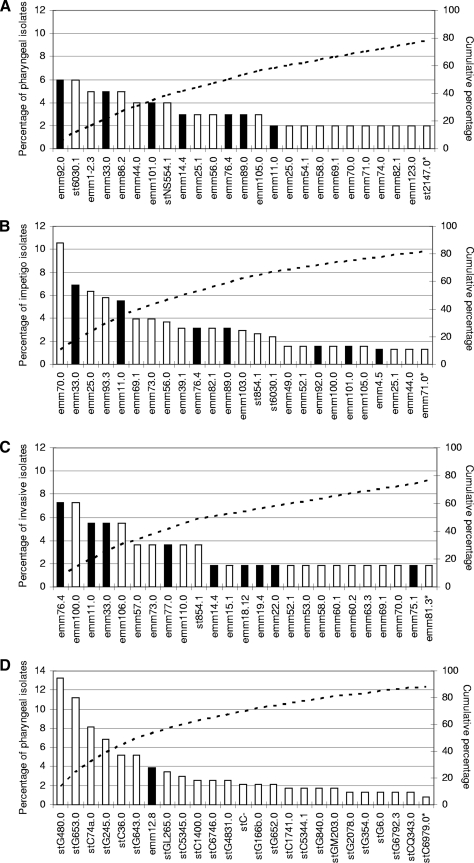FIG. 1.
The 25 most common emm subtypes as proportions of total isolates causing GAS and GCS/GGS disease, grouped by GAS isolates found in the pharynx (A), GAS isolates causing impetigo (B), GAS isolates causing invasive disease (C), and GCS and GGS isolates found in the pharynx (D). (Black bars represent emm subtypes that are included in the current experimental multivalent GAS vaccine, while white bars represent those emm subtypes that are not included; the dotted line represents the cumulative percentage of all isolates). The 25 most common emm subtypes contributing to pharyngeal isolates are shown in panel A (there was a further emm subtype, st854.1, that was ranked 25th equally); these 26 emm subtypes accounted for 78.2% of all pharyngeal isolates, with 21 other emm subtypes contributing to the remaining 21.8%. The 25 most common emm subtypes contributing to impetigo isolates are shown in panel B (there were a further three emm subtypes, emm74.0, emm123.0 and st2147.0, that were ranked 25th equally); these 28 emm subtypes accounted for 86% of all impetigo isolates, with 28 other emm subtypes contributing to the remaining 14%. The 25 most common emm subtypes contributing to invasive isolates are shown in panel C (there were a further 13 emm subtypes, emm82.1, emm86.2, emm87.0, emm101.0, emm104.0, emm105.0, emm113.0, emm116.1, emm123.0, st2037.0, st2147.0, st6030.1.0, and stD631.0, that were ranked 25th equally); these 38 isolates accounted for 100% of all isolates. The 25 most common emm subtypes contributing to GCS and GGS pharyngeal isolates are shown in panel D (there were a further six emm subtypes, st839.0, stC922.0, stG2574.0, stG5420.0, stG652.1, and stGM220.0, that were ranked 25th equally); these 31 emm subtypes accounted for 93.6% of all pharyngeal isolates, with 15 other emm subtypes contributing to the remaining 6.4%.

